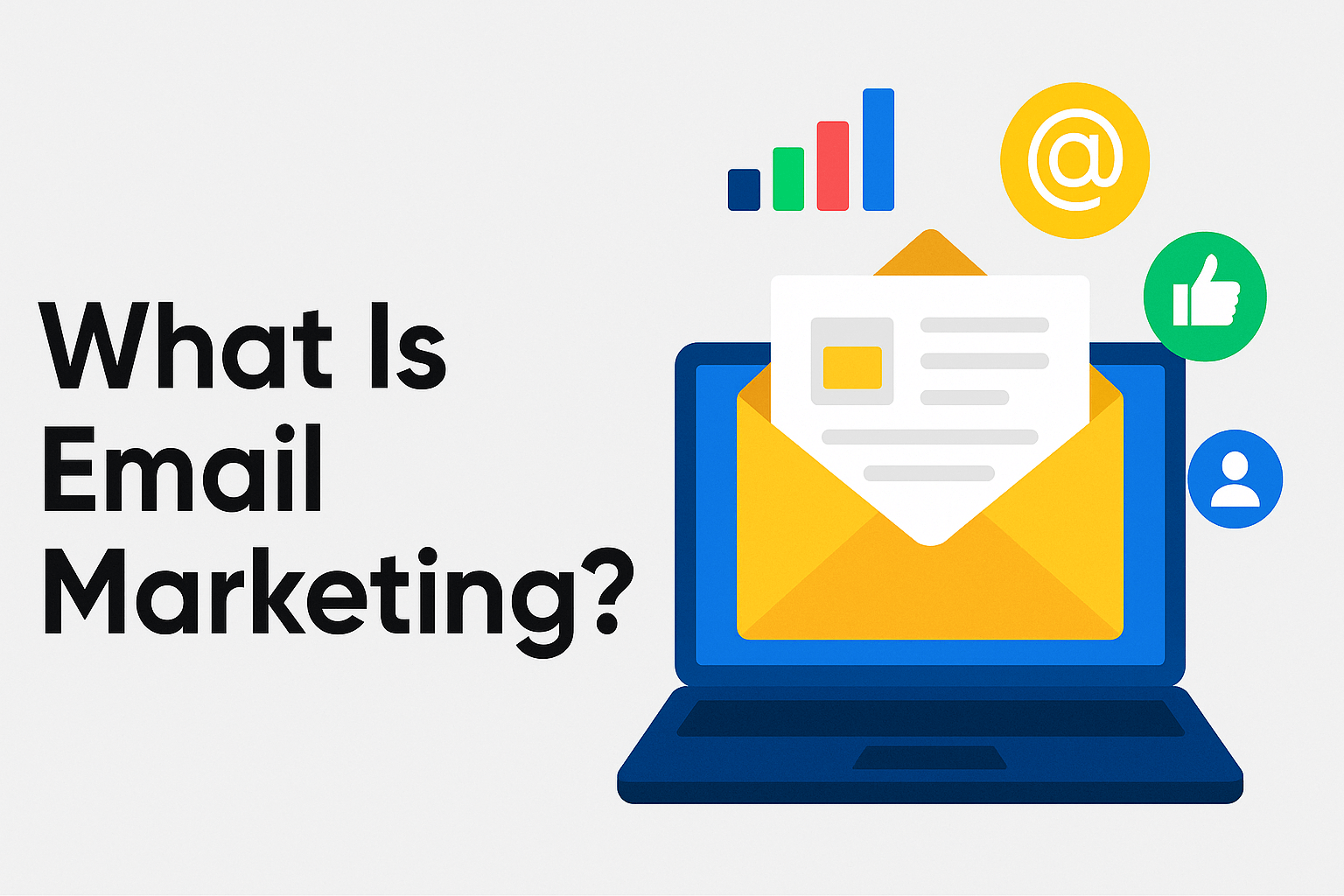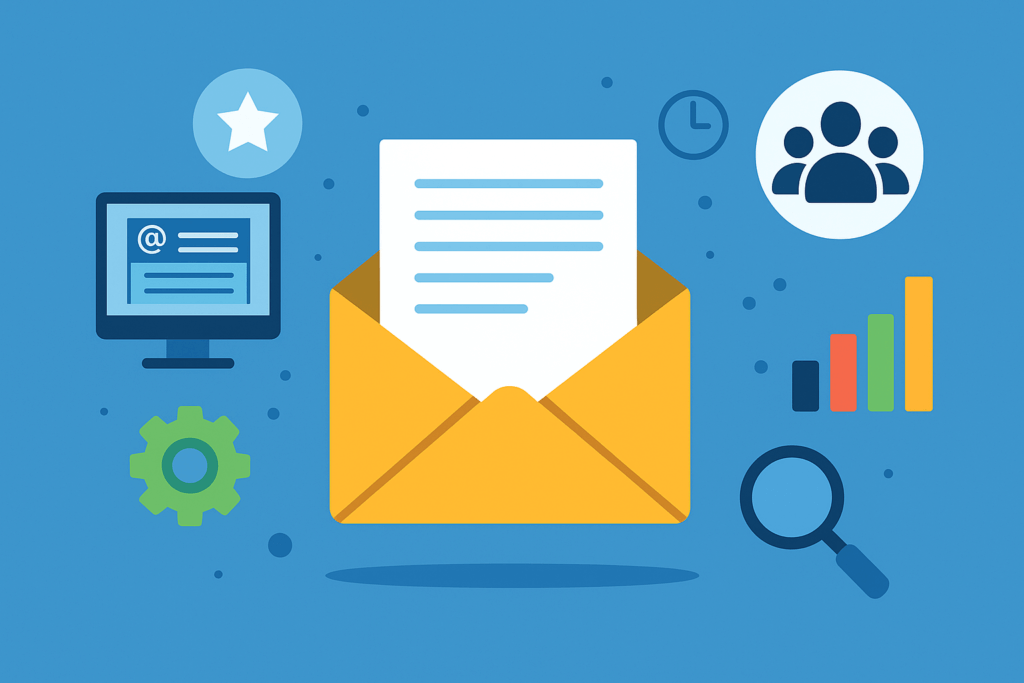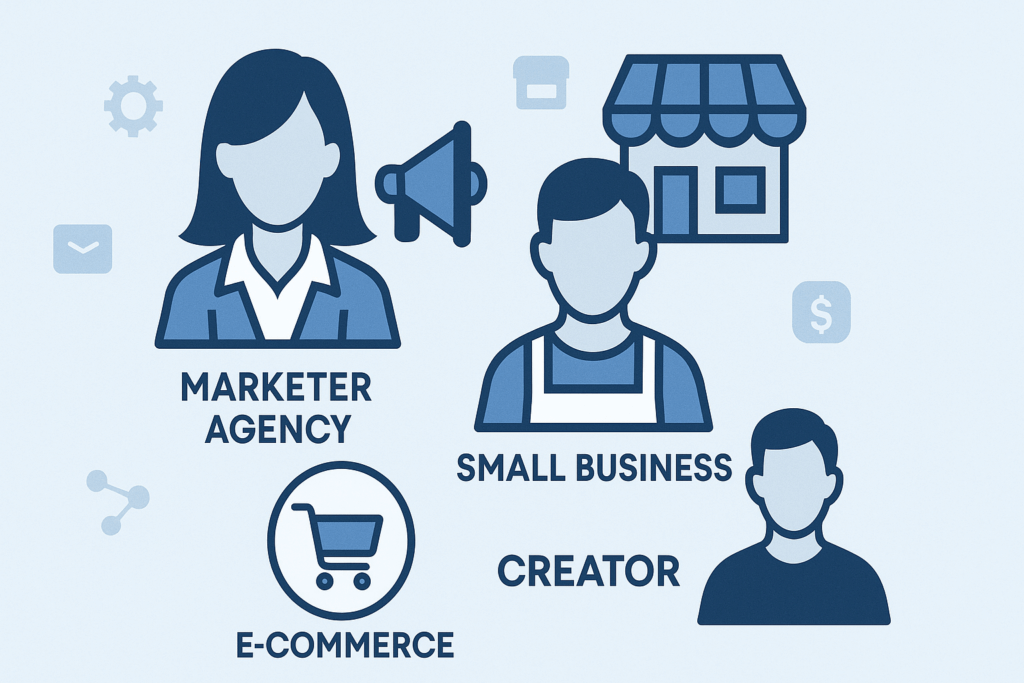
Introduction
If you’re starting your marketing journey, there’s one channel you simply can’t ignore: email. It’s personal, direct, and delivers one of the highest returns on investment (ROI) in the digital world. On average, email marketing generates $36 for every $1 spent, making it one of the most powerful tools in your marketing arsenal.
So why is it so effective?
Email marketing lets you build relationships, educate your audience, and convert subscribers into loyal customers – all in one streamlined workflow. Whether you’re a solo entrepreneur, an e-commerce shop owner, or a B2B marketer, email gives you unmatched control over how and when you engage with your audience.
Unlike social media platforms that are subject to algorithms and reach limits, your email list is something you own. Every message you send lands in someone’s inbox, and that’s powerful.
Plus, modern email tools do so much more than just send newsletters. They offer:
- Visual email builders
- Advanced automation
- Real-time performance tracking
- Audience segmentation & personalization
- GDPR-compliant list management
And if you’re just exploring which tool is best to start with, we’ve reviewed several top players, including Klaviyo, Campaigner, and more, in our best email marketing tools roundup.
The bottom line? If you’re serious about building your brand or business, email marketing isn’t optional – it’s essential.
What Is Email Marketing?
At its core, email marketing is the practice of sending emails to a group of people to promote products, share valuable content, build relationships, or drive specific actions, like purchases or sign-ups.
But it’s more than just sending bulk emails. Today’s email marketing is smart, automated, and personalized.
📬 A Simple Definition
Email marketing is a form of direct digital communication that uses email to:
- Reach potential or existing customers
- Deliver promotional or educational content
- Build long-term audience trust and loyalty
It allows you to speak directly to your audience, in their inbox, on their time.
🔧 Basic Functions Every Beginner Should Know
Here’s a quick breakdown of what email marketing typically involves:
| Function | What Is Does |
|---|---|
| Email List Building | Collects subscribers through forms, landing pages, or integrations |
| Email Campaign Creation | Helps you design, write, and send one-time or recurring messages |
| Audience Segmentation | Divides contacts into groups based on behavior, interests, or demographics |
| Automation Workflows | Triggers emails based on actions (like a welcome series after signup) |
| Tracking & Reporting | Measures open rates, clicks, conversions, and unsubscribes |
| Compliance Tools | Ensures GDPR, CAN-SPAM, and other legal standards are followed |
You can start with simple newsletters, but as you grow, these tools scale with you. Many platforms also offer prebuilt automation templates, A/B testing, and advanced personalization to increase engagement.
And if you’re wondering which platforms offer the smoothest entry point, check out our reviews of Campaigner or Klaviyo. These tools are not only beginner-friendly, but also robust enough to grow with your needs.

Key Features Overview
When you’re choosing your first email marketing platform, it’s easy to get overwhelmed by all the bells and whistles. But don’t worry, once you understand the core features, everything starts to make sense. The best tools out there make your life easier by combining automation, customization, and reporting in one intuitive dashboard.
Let’s break down the most important features you’ll be using as a beginner 👇
🎨 Drag-and-Drop Email Builders
Say goodbye to complicated code. Most tools now offer visual editors where you can drag blocks, images, buttons, and text into place.
- Build beautiful, mobile-optimized emails in minutes
- Use pre-designed templates or start from scratch
- Preview your email before sending to make sure it looks perfect
💡 Tip: Tools like MailChimp and Brevo are known for user-friendly editors perfect for beginners.
⏰ Automation & Scheduling
You don’t want to be glued to your screen every time you send an email. That’s where automation steps in.
- Welcome new subscribers with a pre-written series
- Send reminders for abandoned carts or upcoming webinars
- Trigger messages based on behaviors (opens, clicks, purchases)
A great example of this is Klaviyo, which offers advanced automation flows that are still easy to set up.
📊 Reporting & Analytics
If you’re not measuring, you’re guessing. Email tools come equipped with dashboards to help you track:
- Open rates (Who’s actually reading your emails?)
- Click-through rates (Are people engaging with your content?)
- Unsubscribe rates (Are you overwhelming or missing the mark?)
- Conversion tracking (Are your emails making you money?)
Here’s a quick comparison table of analytics features across top tools:
| Tool | Real-Time Reporting | A/B Testing | E-commerce Tracking |
|---|---|---|---|
| Brevo | ✅ | ✅ | ✅ |
| Klaviyo | ✅ | ✅ | ✅ |
| Campaigner | ✅ | ✅ | ✅ |
| MailChimp | ✅ | ✅ | 🔁 (via integration) |
🧑🤝🧑 List Management & Segmentation
Not all subscribers are the same, and that’s a good thing. With smart segmentation, you can send personalized content to:
- New customers
- Returning buyers
- Inactive readers
- High spenders
This helps improve engagement and reduce unsubscribe rates.
🛡️ Deliverability & Legal Compliance
You want your emails to land in inboxes, not spam folders. Good email tools help you:
- Authenticate domains (SPF, DKIM)
- Monitor sender reputation
- Stay compliant with GDPR and CAN-SPAM regulations
💡 Always include an unsubscribe link and make permissions clear. Trust builds loyalty.

Who Should Use Email Marketing Tools?
You might be wondering: Is email marketing really for me?
Short answer: Yes. Whether you’re running a solo side hustle or managing campaigns for a growing e-commerce brand, email marketing scales with you and gives you a direct line to your audience.
Let’s look at who benefits most from using email marketing tools 👇
🧑💼 Marketers & Agencies
If you’re working in marketing, content, performance, or CRM, email should be a core part of your strategy.
- Launch products with teaser campaigns
- Promote blog content to drive more traffic
- Re-engage cold leads with personalized offers
- Track conversions to prove ROI
Tools like Brevo and Campaigner offer advanced automation and performance dashboards tailored for professionals.
🏪 Small Business Owners
Running a café, yoga studio, or online shop? You need to stay in touch with your customers, and email is the cheapest way to do it.
- Send out seasonal promotions or flash sales
- Remind customers of appointments or special events
- Share updates about your business, new products, or holiday hours
Best of all? You can do this in under 30 minutes a week with a template and scheduling tool.
🛒 E-commerce Stores
If you’re in e-commerce, email isn’t optional; it’s your lifeline for customer retention and revenue growth.
- Recover sales with abandoned cart emails
- Upsell or cross-sell with product recommendations
- Automate post-purchase sequences to increase lifetime value
- Highlight limited-time deals or new arrivals
💡 Tools like Klaviyo are designed specifically for e-commerce workflows and integrate seamlessly with Shopify, WooCommerce, and BigCommerce.
🎨 Creators, Coaches & Solopreneurs
If you’re building a personal brand, growing a newsletter, or selling courses, email gives you direct access to your fans and clients.
- Deliver exclusive content or bonus materials
- Launch new offerings with sales sequences
- Build community with weekly updates and tips
Start simple with platforms like MailChimp, which are great for creators and have generous free plans.
The beauty of email marketing is that it’s flexible. You don’t need a massive list or a big budget to get started. You just need the right tool, the right message, and the commitment to show up in your subscribers’ inboxes with value.
Common Examples of Email Marketing Tools
Choosing the right email marketing tool is like picking your marketing co-pilot. You want something easy to use, powerful under the hood, and scalable as your needs grow.
Here’s a quick tour of some of the most popular and beginner-friendly email platforms you should consider, each with its own strengths:
Brevo – Your All-in-One Marketing Suite
If you’re looking for power and flexibility without the complexity, Brevo is a top choice.
- Drag-and-drop email builder
- Built-in CRM and SMS capabilities
- Marketing automation that’s beginner-friendly
- Strong focus on deliverability and compliance
- Scales easily as your business grows
✅ Why we recommend it: Brevo is ideal for those who want a versatile platform with great automation, especially if you’re juggling both email and SMS campaigns.
🔗 Read our full Brevo review
Mailchimp – The Gateway for Beginners
Mailchimp has long been the go-to tool for beginners thanks to its user-friendly interface.
- Visual campaign builder
- A/B testing made easy
- Lots of templates for newsletters
- Detailed analytics dashboard
- A generous free plan
✅ Why we recommend it: It’s simple, clean, and great for basic newsletters or seasonal campaigns, especially if you’re just getting started.
🔗 Read our full Mailchimp review
MailerLite – Clean, Focused, and Affordable
MailerLite offers an uncluttered experience and all the essentials without a steep learning curve.
- Excellent for sending beautiful emails fast
- Intuitive automation builder
- Landing pages and signup forms included
- Affordable pricing, even for small lists
✅ Why we recommend it: It’s perfect for creators and solopreneurs who want a streamlined tool to build and nurture their audience.
Klaviyo – The E-commerce Specialist
Built for stores that sell online, Klaviyo is a performance-driven email platform with deep integrations.
- Advanced segmentation for targeting
- Prebuilt flows for abandoned carts, upsells, and reorders
- Shopify and WooCommerce integrations
- Real-time revenue tracking
✅ Why we recommend it: If you’re running an e-commerce shop, Klaviyo is tailor-made for your sales goals.
🔗 Read our full Klaviyo review.
📢 Campaigner – Advanced Features Without the Bloat
Campaigner stands out for its professional-grade tools and excellent targeting features.
- Dynamic content personalization
- Responsive templates
- A/B and multivariate testing
- Integrates with CRMs and e-commerce platforms
- High deliverability rates
- ✅ Why we recommend it: For marketers ready to level up beyond basic email blasts, Campaigner delivers serious functionality.
🔗 Read our full Campaigner review
Conclusion: Choosing the Right One to Start
So, which email marketing platform should you start with? That depends on your goals, technical comfort level, and how quickly you plan to scale. But the good news? There’s a perfect-fit tool for everyone, and you don’t need to overcomplicate it.
Here’s a simple guide to help you make your decision:
| If you are… | Start with… |
|---|---|
| A small business owner or solopreneur | Mailchimp – Easy setup, beautiful templates, generous free plan |
| Looking for a CRM-integrated platform | Mailchimp – Easy setup, beautiful templates, generous free plan |
| Running an e-commerce store | Klaviyo – E-commerce automation and revenue insights built in |
| Ready for serious segmentation and testing | Klaviyo – E-commerce automation and revenue insights built-in |
🎯 What to Look for When Choosing a Tool
- Ease of Use: Can you build and send a campaign in under 30 minutes?
- Templates & Design: Are there prebuilt options that match your brand vibe?
- Automation: Does the tool help you save time and scale smartly?
- Integrations: Can you sync it with your store, website, or CRM?
- Pricing: Does it offer a free tier or affordable entry-level plan?
FAQ
1. What is email marketing in simple terms?
Email marketing is the practice of sending targeted emails to a list of subscribers to build relationships, promote offers, or share updates – all through their inbox.
2. Is email marketing still effective in 2025?
Yes! Despite the rise of social media and chat apps, email marketing delivers one of the highest ROIs – around $36 for every $1 spent – thanks to its direct, personalized nature.
3. Which email marketing tool is best for beginners?
Start with Mailchimp for a beginner-friendly experience. If you’re looking for more advanced automation, Brevo is highly recommended. E-commerce store? Klaviyo is your best bet.
4. How do I grow my email list from scratch?
Use popups, embedded forms, landing pages, or lead magnets (like discount codes or free guides). Tools like Brevo and Mailchimp include these features out of the box.
5. What kinds of emails can I send?
You can send:
- Welcome emails
- Newsletters
- Product announcements
- Promotional offers
- Abandoned cart reminders
- Re-engagement campaigns
Each type serves a specific purpose in the customer journey.
6. What is email automation?
Automation allows you to send emails based on user actions, like subscribing, making a purchase, or abandoning a cart. It saves time and ensures the right message reaches the right person at the right time.
7. Can I personalize emails for my audience?
Yes. Most tools let you insert the subscriber’s name, reference their past purchases, or tailor content based on behavior or location. Personalization increases open and click-through rates.
8. What’s a good email open rate?
A solid benchmark is between 20%–25%, though this can vary by industry. Using compelling subject lines, personalized content, and clean lists can boost your open rates.
9. Do I need a website to start email marketing?
No. While a website helps, many tools (like Campaigner or Brevo) offer hosted landing pages and forms so you can collect subscribers and send emails without one.
10. How often should I email my subscribers?
Once a week is a good starting point. Stay consistent without overwhelming your audience. Monitor engagement to decide if you should email more or less frequently.






